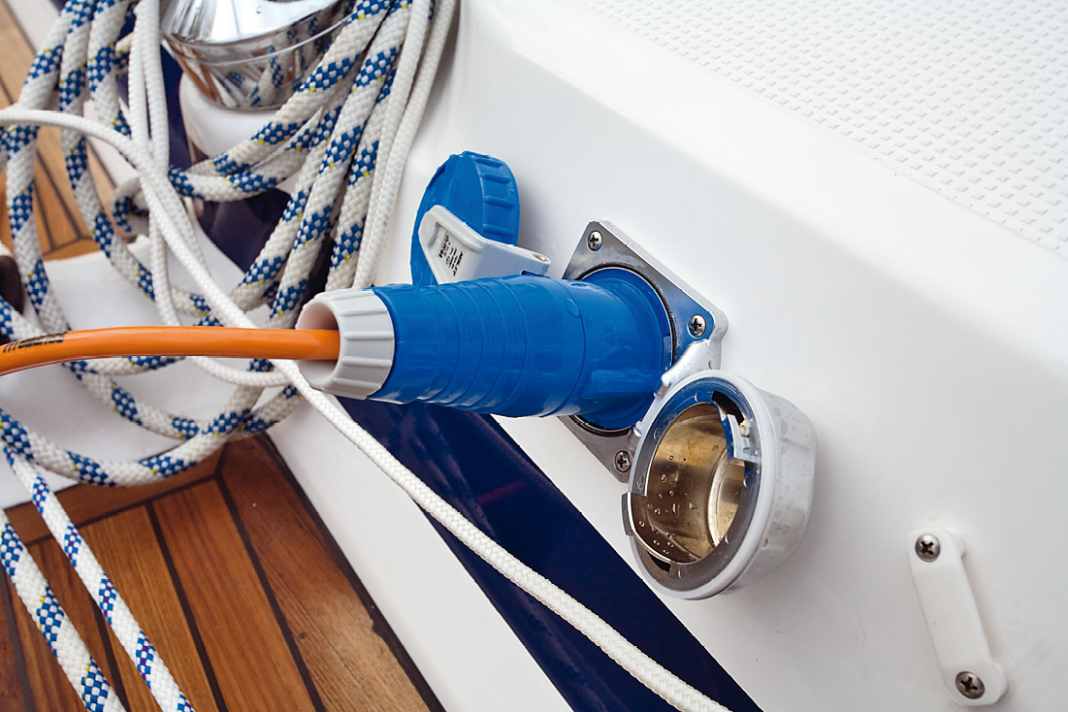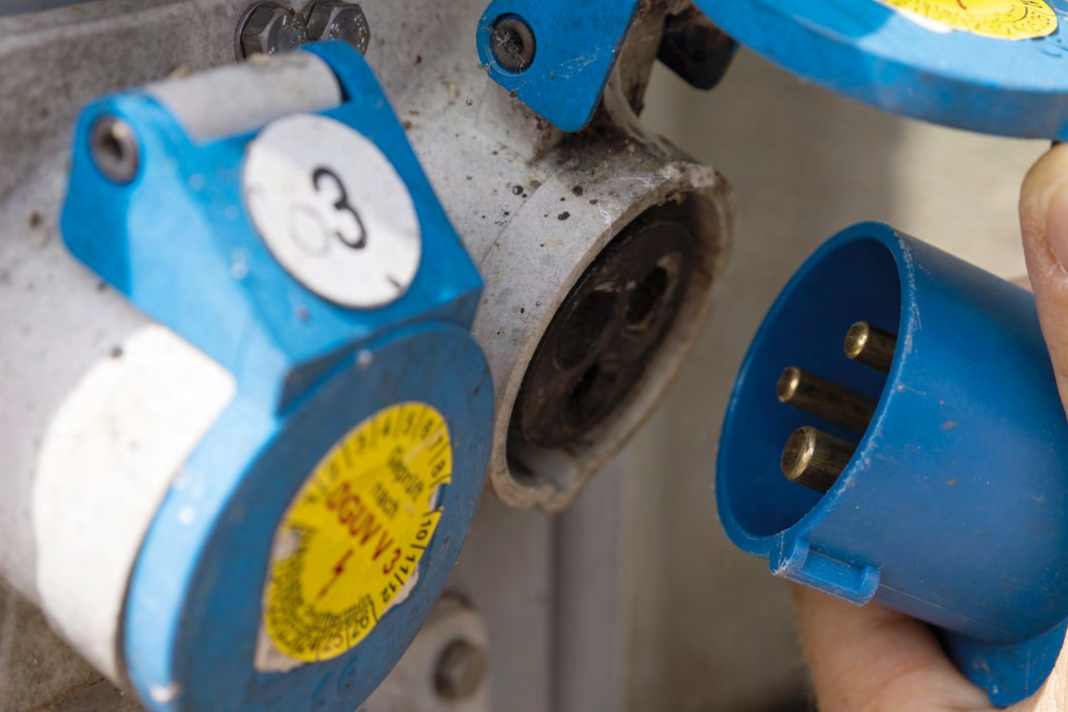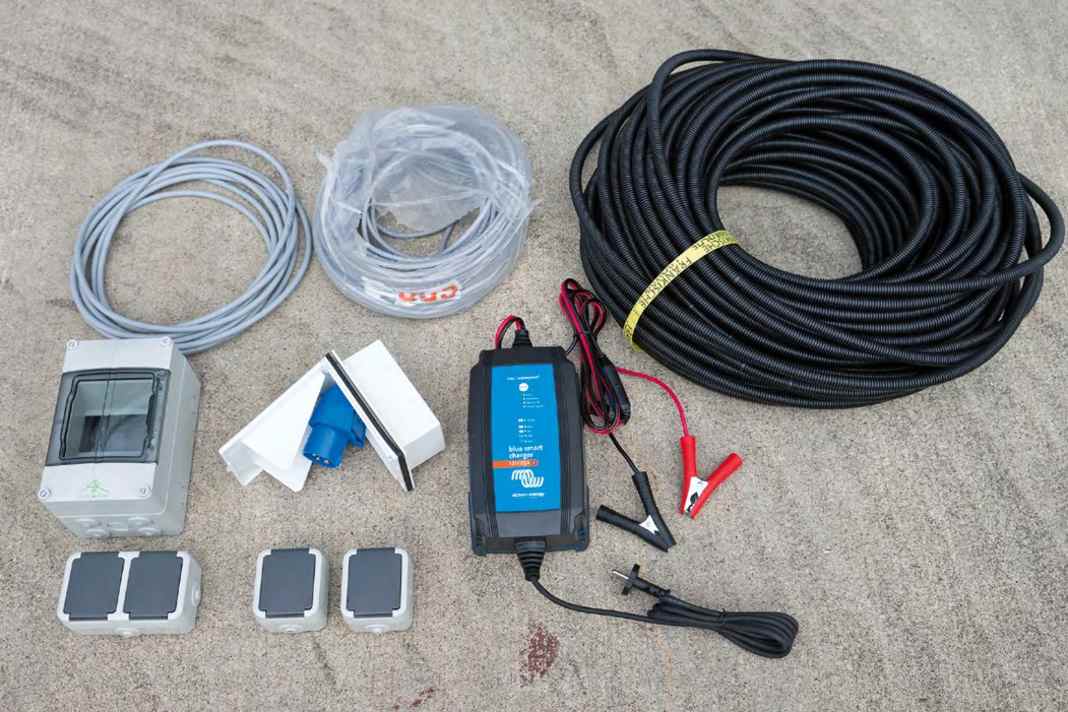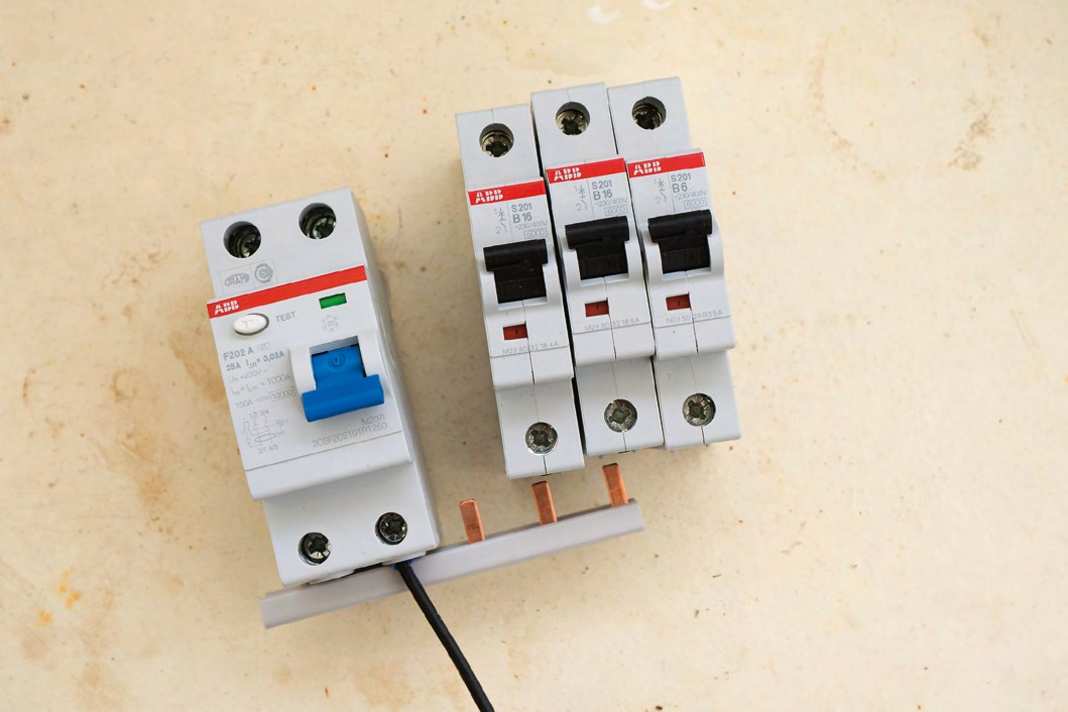





In this article:
The first day of sailing with the second-hand yacht was a pleasure. The relatively new sails stood perfectly, the sea behaviour proved to be pleasant and the mooring manoeuvre under engine worked without any problems. The boat is now safely moored. Quickly lay the shore power cable and the cosy part of the day can begin.
Well, yes. The previous owner left a rather untrustworthy old power cable in the cockpit locker, which he plugged into the nearest Schuko socket on the jetty. The battery charger is connected to the multiple socket that hangs on the cable in the cockpit. Can an electric ceramic fan heater also be connected there with a clear conscience? After all, faulty electrics are the most common cause of fires on yachts. "The cause of the fire can be traced back to this in around 80 per cent of cases," explains Holger Flint. The head of the claims department at Hamburg-based yacht insurer Pantaenius also reports a significant increase in fire damage. "In 2017, we had a share of around 10 per cent, currently we have almost 20 per cent of the total number of claims, with the total claims volume disproportionately high at around 26 per cent. Fire damage logically remains one of the most common causes of total losses."
There is an urgent need for action in the case of ageing electrics, regardless of whether the boat was bought second-hand or has been owned for some time. On our example yacht, the shore power should be brought on board safely in future and supply a 230-volt power grid with five sockets in the yacht.
Danger to life - non-professional electricians should seek professional help
In our case, Torsten Roth from the Bremerhaven-based company Roth Funktechnik & Yachtelektrik provides the support. Roth lists the materials required for a 230-volt alternating current supply. The expert offers that owners can initially carry out the time-consuming but less demanding work steps themselves. Laying the power cables and installing the shore power connection, small distribution box and sockets on board can save a day's labour. Understandably, only components provided by the electrician and approved by the German Association for Electrical, Electronic & Information Technologies (VDE) may be installed. "After all, I'll take the rap if something doesn't work," explains 47-year-old Roth.
DIN EN ISO 13297 "Small craft - Electrical systems - Alternating current installations" is decisive for work on a 230-volt power supply on yachts. "This standard is used for personal protection, the safety of electrical systems and fire protection on small watercraft," states the homepage of the DIN Ship and Marine Technology Standards Centre (NSMT) in Hamburg. Small watercraft are defined as having a hull length of less than 24 metres. The fact that this standard is only available as a PDF file costing around 100 euros reduces the likelihood of yacht owners obtaining it. A professional electrician, on the other hand, knows what is prescribed. Another reason for professional support: "With the combination of 230 volts and water, you should know exactly what you're doing," warns Torsten Roth. An electric shock from 230 volts can be fatal. "Half-knowledge and electricity are generally not a good combination, not even with 12 volts," explains Roth, referring to the sometimes adventurous electrical installations on yachts.
Components from commercial shipping are safer than yacht accessories
As Torsten Roth and his three employees have not only been working for yacht yards since 1999, but also regularly on commercial vessels, he prefers to use the industry standard prescribed for commercial shipping. "If you use the right components, they are classes above those specially manufactured for the yacht sector." It goes without saying that the fancier yacht components must also have VDE approval.
The first step is to dispose of the old power cable from the previous owner. In European marinas, CEE power distribution is the only permissible system for shore power at the power columns. The CEE plug and coupling belong directly to the shore power cable, the blue plug is plugged into the power column. According to Roth, a three-core cable with a cross-section of 1.5 square millimetres can be used up to a cable length of 15 metres. From a cable length of 25 metres, 2.5 square millimetres are prescribed. Dividing a long shore power cable into more manageable lengths is nonsense. The cable must be "routed from the shore power to the ship without interruption". "Every plug connection weakens the system," explains Roth. Nor should two cables with different cross-sections be combined. A cable cross-section that is too thin leads to voltage losses. In the worst-case scenario, only 200 volts will reach the vehicle instead of 230. The remaining 30 volts are left on the cable length. This voltage has been "burnt" into power, i.e. heat.
The danger of possible cable fires sends shivers down the spine of the specialist
It is risky, for example, if several Schuko cable reels are connected in series to a CEE Schuko adapter in order to lead the shore power over long distances to the yacht. Or when two yachts use a CEE-Y cable with one plug and two couplings on the power column in busy harbours. "Please avoid both at all costs!"
The CEE coupling and plug are secured with a spring-loaded cover and a latch or a small push lever. This prevents the plug connection from disconnecting unintentionally. There are also smaller, more elegant shore power adapters whose body housing and plug are VDE-approved. "But they usually give up the ghost more quickly. The contact surfaces are much smaller than with CEE and therefore burn out quickly," says Roth. On larger yachts, two shore-side power outlets are installed. Depending on how the yacht is moored, the shore power cable is plugged into the bow or the stern. A changeover switch must ensure that no 230 volts are applied to the poles of the coupling that is not currently in use.
From the shore power takeover, as the plug connection to the cable is called in technical jargon, a cable no more than one metre long is laid to the on-board fuse box with residual current circuit breaker. All 230-volt power cables must then start there. Torsten Roth considers it excessive to use robust PUR cable on a yacht. The same goes for cables that are approved for commercial shipping. He favours flexible, oil-resistant oil-flex cable.
Standard household cables are a no-go!
Under no circumstances should cables with rigid wires be used on board as at home - they could break due to vibrations. Instead, each cable must consist of individual flexible wires, so-called strands. The cross-section of the conductors must be at least 2.5 square millimetres. The actual power cable is routed through VDE-approved, highly flexible protective conduit. This corrugated conduit is temperature-resistant, UV and oil-resistant and fulfils the IP65 standard, meaning it also offers protection against water jets. At the sockets, the cable is routed into the housing from below to prevent moisture from flowing in along the cable.
Once all the sockets have been fitted and the power cables have been laid in their protective conduits, the electrician comes on board to connect them. Before starting work, the boat is first de-energised: the shore power cable is disconnected and the batteries disconnected.
All installed 230-volt electrical cables converge at the fuse box known as the small distribution board. According to DIN EN ISO 13297, a residual current device (RCD) must be present in the moisture-prone environment on board. The fuse, also known as a personal circuit breaker, must be located within one metre of the shore power supply. "The personal circuit breaker is absolutely essential on board," says electrician Roth. "You never know whether the power supply on the jetty is protected by one. If you don't have an RCD on board, you can install the circuit breaker in a portable box on the shore power cable, which is better than nothing."
If everything is in order in an electrical circuit, just as much current flows towards the consumer as away from it. However, a fault, such as damaged insulation, can also cause some of the current to flow away instead of back through the line. In the worst case scenario, through an earthed person. To ensure that there is no danger to life even in the event of an electric shock, the RCD compares the amount of current on the outward and return path. If the difference is more than 30 mA, both poles are disconnected immediately. Incidentally, the RCD only triggers if 230 volts actually reach it. This makes it easy to check the shore power using the test button. If the full voltage is present, pressing the button should interrupt the circuit immediately.
To ensure that the circuit breaker is working correctly, the test button should be pressed regularly. The test interval can be found in the documentation for the RCD.
On-board FI triggers- These can be the causes
If the RCD triggers in everyday life on board, there are two classic reasons for this. "The most common is moisture in the shore power socket," says Roth. Followed by the hot water boiler. "At some point, the heating cartridge or the heating rod in the boiler breaks down. Or in spring, the boiler starts up when the water tank has not yet been topped up. Then the heating cartridge runs dry and the RCD trips."
If you also produce 230-volt electricity on board with a generator or inverter, you must technically exclude the possibility of this reaching the shore connection. Otherwise, the current could be present at the CEE plug of the shore power cable at the poles that are not protected against contact. The connection of the required changeover system should be carried out by a professional.
A mains indicator light installed in the small distribution board or on the card table is practical. This recognises when the N and L conductors are reversed. This can only happen with a pure CEE installation if the plug has been connected incorrectly. However, if shore power is only available in a harbour with a Schuko-CEE adapter, it is up to chance which conductor catches N and which catches L without an indicator light. This is irrelevant for the electrical function, but the cable intended for L must also carry L.
Is a fire protection switch necessary on board the yacht?
An additional fire protection switch (AFDD = Arc Fault Detection Device) in the small distribution board also detects arcs in faulty electrical installations. These can form in the event of interruptions and insulation faults caused by vibrations, thermal expansion or shrinkage, severe cable kinks, high mechanical loads, corrosion and ageing. In both cases, the AFDD disconnects the circuit before electrically ignited fires occur.
Roth believes the AFDD is dispensable. "I have never seen a fire protection switch on a new production yacht. Put simply, you can say that cable fires only occur if the installation is not done properly," explains Roth. However, in 99 per cent of cases, a cable fire occurs in the battery network anyway. This is where the significantly higher current flows at low voltage. This is particularly the case if an inverter is used, as this can draw very high currents on the 12-volt side.
Back to the 230-volt installation: Automatic circuit breakers for the individual circuits are installed in the small distribution board. If you know your maximum current, you can size your fuses accordingly and play it safe even in unfamiliar harbours. In most cases, a six-amp circuit breaker would trip before the marina system, but may already be too weak for the battery charger or a powerful hoover.
The PE conductor problem: How to prevent galvanic corrosion
DIN EN ISO 13291 stipulates that the protective conductor of the alternating current must be connected to the ship's earth. The negative terminal of the on-board battery or the engine can be used as the ship's earth, or the hull in the case of metal yachts. This means that the engine, shaft system, saildrive, rudder system, sea valves and much more are also connected to the shore current protective conductor, which can lead to galvanic equalising currents.
When two metals with different electrochemical potentials are immersed in a conductive liquid and connected by a conductor, a current flows and the inferior metal dissolves. On board, for example, this could be the aluminium saildrive and the rusty harbour sheet piling. The conductive liquid is the seawater, and the protective conductor of the shore power connection provides the electrical connection.
Before components such as propellers, sea valves or the rudder stock made of inferior metal dissolve, the sacrificial anodes on the propeller and/or the hull first decompose. In extreme cases, blistering or even pitting can also occur on an aluminium hull if there is a sufficiently large amount of copper in the antifouling coating of the neighbouring yacht or if the earthed sheet piling in the harbour is rusty.
Isolating transformers and isolators
Galvanic corrosion ends as soon as the circuit is interrupted, i.e. when the shore power connection is disconnected and the protective conductor is no longer connected. To fulfil the regulations and use shore power without risk, an isolating transformer is required. This decouples the shore power system cleanly from the on-board power supply, but costs at least 1,000 euros.
"On aluminium yachts, I think an isolating transformer is an absolute must. Otherwise, I only recommend it if there are demonstrable problems," says Roth. "The owner needs to take a closer look if one day, a rock wall next to their permanent berth is replaced by a sheet pile wall. This increases the risk of galvanic corrosion during shore power operation."
Alternatively, ISO 13297 allows galvanic decoupling from the shore connection, provided it is designed to be fail-safe. Correspondingly certified galvanic isolators are similar in price to an isolating transformer. Many of the isolators offered as "zinc savers" do not fulfil the fail-safe requirement and are therefore unsuitable.
The 230-volt power supply on board is now in place. Electrician Roth takes another look at the 12-volt network and replaces the cables between the engine's alternator and the batteries with highly flexible ones with a suitable cable cross-section and neatly crimped tubular cable lugs in protective conduits.
The 12-volt distribution on the chart table is also checked: "I see some adventurous things on this example boat, but at least there is no danger to life," says Roth. This is reassuring, explains Pantaenius spokesman Jonas Ball, but: "The older a boat is and the more previous owners have tinkered with the electrics, the more likely it is that components not suitable for damp locations or incorrect cable cross-sections have been installed, or that other problems will occur." The 12-volt power supply is therefore certainly a worthwhile optimisation project on a used yacht, but also on a yacht that has been owned for some time.
Plug and cable for shore connection




The de-energised installation: what owners can do themselves






Wiring and commissioning: this is where a professional comes in







